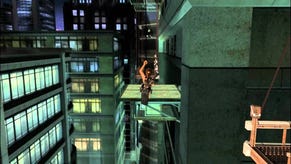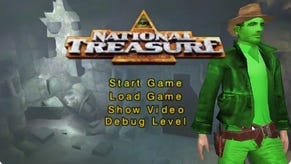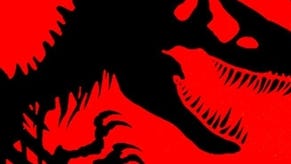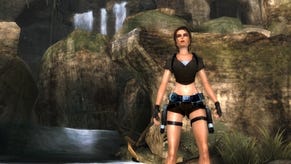Tomb Raider: Anniversary
Stuff of Legend.
When a preview version of this celebratory remake of the original Tomb Raider turned up in the post, it seemed like it would be fitting and respectful to do a little archaeology ourselves. Vaults were cracked open, dust brushed, ancient code decyphered; the trash and treasures of a long-lost era were rifled through on a quest for answers. The Tomb of PlayStation the First was gutted in search of a copy of Core Design's 1996 classic. When we eventually unearthed one, and subjected it to the harsh glare of modernity (in the form of a PS3, an HDMI cable and an acreage of liquid crystal Lara herself would think twice about scaling) we got a couple of shocks.
The first was unpleasant. The game looked and felt a lot more than eleven years old. The grey Peruvian caves were rendered in wobbling, jagged pixels the size of your fist, and Lara jogged around them excruciatingly slowly, fumbling and shuffling hesitantly towards every awkward jump and laboured clamber.
The second shock, though, was much more pleasant, and much more of a surprise. Beneath the clumsy controls and technical limitations was an incredibly modern, forward-thinking game. Its cinematic style, rich atmosphere, and pitch-perfect pacing were all way ahead of their time. So were the lock-on third-person gunplay, the dynamic musical score, and the slick, clean interface. Here, in short, was a game absolutely crying out for the remake treatment: virtually unwatchable and unplayable by current standards, but still totally relevant.

As we reported back in February, the tack Eidos and Tomb Raider: Legend developer Crystal Dynamics have taken with this new version is to preserve the spirit, story and structure of the original, but rewrite the details to fit the Legend template. Although it includes all the original game's settings and most memorable moments, Anniversary looks and plays almost exactly like the classy Legend, itself heavily inspired by Ubisoft's recent Prince of Persia games.
You have fully analogue control of Lara, and the focus is on stringing together long chains of fast, flowing acrobatic moves to navigate the crumbling tombs. Her acrobatic range is as it was in Legend, including the grappling hook and ledge-hanging moves, and the use of the triangle button to recover quickly from a bad landing, or rhythmically speed up climbing moves. A new, minor new addition is the ability to jump to and balance on very small platforms, such as the tops of poles.
It's still an intuitive, beautifully animated and richly satisfying platforming system, and going by the first few levels of the game, it seems likely Anniversary will exploit it more fully than Legend did. In attempting to recreate the feel of the original Tomb Raider, Crystal Dynamics has reined in its penchant for blockbusting set-pieces, done away with all but a few human characters and discarded gadgets like the clue-giving binoculars. Anniversary is all about Lara, alone, making her way through frighteningly huge and deserted ruins, negotiating traps and puzzles with the bare minimum of equipment. Even in the early levels we've played - all in Peru, the first of the game's four locations, which also include Greece and Egypt - the scale and intricacy of the environments are a step up from Legend's, and the routes through the biggest complexes of rooms are noticeably less linear. They're also even better suited to the returning Time Trials.
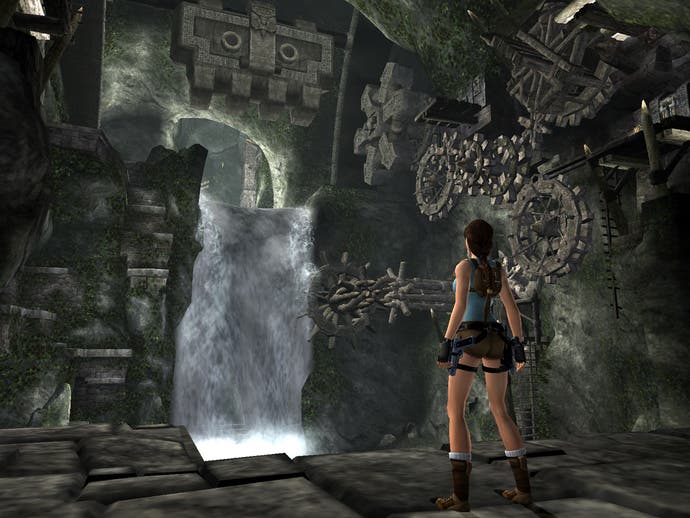
The game's desolate atmosphere has also required a few small changes to Legend's combat system. This is because, in keeping with the original game, you'll largely be fighting beasts, not men: wolves, bats, panthers, dinosaurs - seems time has been forgetting itself and mislaying valleys again, the sieve-for-brains. The animals' lack of projectile weapons (or the prehensile digits to operate them) and their charging attack patterns force a different rhythm on fights.
Lara's melee attacks have been stripped out, as have the showy, scripted environmental interactions. In their place are a quick knockdown recovery, and the adrenaline dodge. The latter is a slow-mo acrobatic dodge that can be engaged when an assailant gets enraged and charges, blurring the screen; hit X while somersaulting out of the way to dispatch the beast with a mid-air headshot. Both moves help ease the genuine frustration and panic of the combat, a double-edged sword that's been all-too-accurately transposed from the 1996 Tomb Raider. Fights are less staged than they were in Legend, more messy, and more genuinely scary.
There are one or two moments that are the exact opposite, though. Occasionally during these first few levels - very, very occasionally - Anniversary uses the button-prompt interactive cutscenes that featured in Legend, and are pretty much de rigueur in any headlining, mass-market action-adventure these days. They don't sit nearly so well in the sparse, contemplative surroundings of pure Tomb Raider. That said, considering they're mostly used to add spice to something that was a prerendered CGI sequence 11 years ago, they're pretty inoffensive. With one exception.
It was never going to be the same second time around, of course. But the appearance of the T-rex in Tomb Raider still ranks in most people's top ten gaming moments for a reason - because it came out of nowhere in the course of regular play, and because, terrifyingly, Lara had to deal with the gigantic monster just as she would with any other animal. In Anniversary, the moment's been neutered, turned into a by-the-numbers boss fight book-ended with scripted, Simon-says set-pieces that must have been supposed to make it more dramatic, but in fact make it less so.
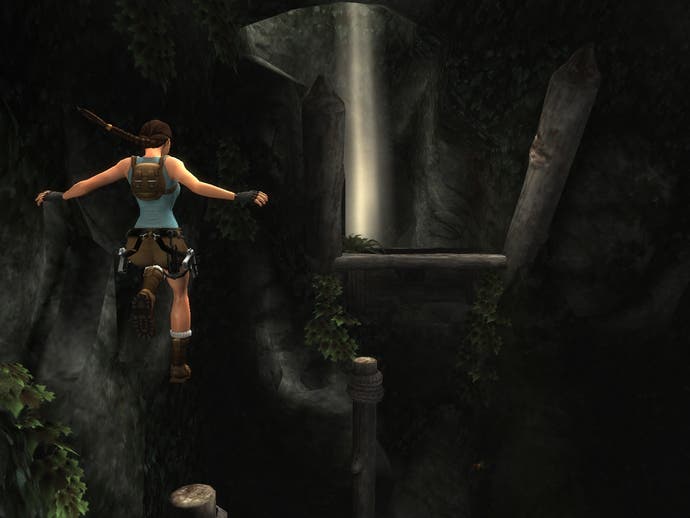
However, it says a lot about Tomb Raider: Anniversary - and just as much about its inspiration - that in the first three levels, it's only this one moment where old and new are in less than perfect harmony. On paper it's the ideal remake, fresh and nostalgic at the same time, capturing the eerie atmosphere no Tomb Raider has had since 1996 and blending it with the smooth, easygoing elegance Crystal Dynamics brought to the series ten years later. The slick graphics and superlatively creepy sound - including a subtle musical score that is, unbelievably, an improvement on the original - are the icing on the cake. It's as much a sequel to Legend as a remake of Tomb Raider, and thanks to its purity of focus, it might even better last year's game.
What remains to be seen is whether Crystal Dynamics' reworked level design is interesting and challenging enough to sustain interest over its entire length, without resorting to the showboating that worked well enough in Legend but, as the T-Rex incident shows, can only cheapen this long, lonely experience. On the basis of the hypnotic, echoing halls we've seen so far, it has every chance.




